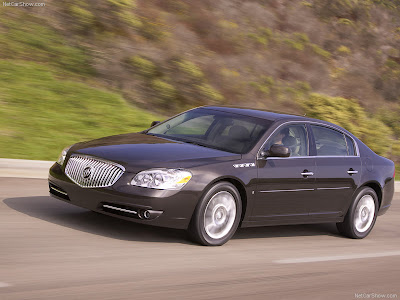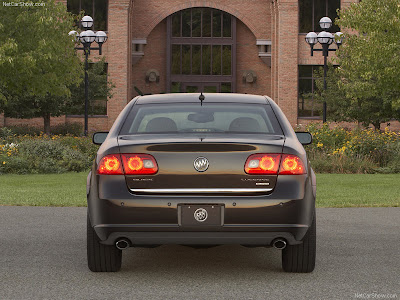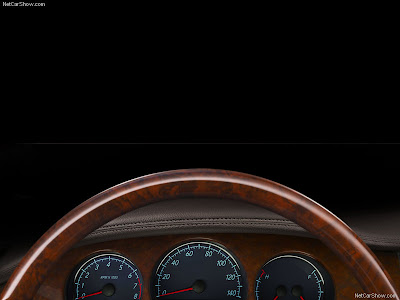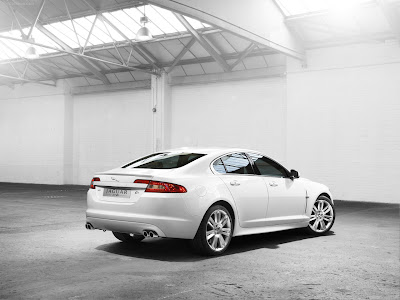







Buick Lucerne Super
Buick Primes The New York Auto Show With Early Introduction Of New 'Super' Models
Buick has rekindled a name from its storied 20th-century past to mark the beginning of a new level of refinement: Super. The badge is designated exclusively for Buick's most premium, powerful models and returns to Buick vehicles after 50 years. It will debut on the 2008 model year LaCrosse and Lucerne sedans.
"We're bringing back the Super badge to represent our most premium models," said Steve Shannon, Buick general manager. "Our Supers are not just about increased horsepower; they represent an elevation in design, premium content and ride characteristics that are exclusive to the Super badge."
The Supers are engineered for Buick by the GM Performance Division to inspire performance on demand. The LaCrosse Super is powered by a 300-horsepower (224 kW) 5.3L small-block V-8 with GM's Active Fuel Management technology. The LaCrosse Super's chassis has been sport-tuned to deliver responsive handling characteristics, and the vehicle maintains Buick's renowned quietness inside.
The Lucerne Super adds a more powerful version of the legendary 4.6L Northstar V-8. It is rated at 292 horsepower (218 kW), an increase of more than 6 percent over existing models. The Super has an enhanced chassis with a specially tuned version of Lucerne 's Magnetic Ride Control system, for a refined, premium ride that simultaneously enables crisp, responsive handling.
Buick Super: elevated design, power and performance
Design elements on the LaCrosse Super and Lucerne Super denote the new face of Buick. Design cues echo those seen on the popular Velite convertible concept vehicle - and recently introduced on the Buick Enclave luxury crossover SUV - including a new waterfall grille and portholes. The LaCrosse Super is the first and only LaCrosse model offered with Buick's iconic portholes; there are four per side to highlight the V-8 engine.
In addition to distinctive design, the LaCrosse Super and Lucerne Super deliver leading-edge performance and refinement. The 5.3L and 4.6L V-8 engines are renowned for balancing performance and fuel economy. They are complemented by specially tuned suspension systems.
Like all Buick models, LaCrosse and Lucerne Supers are built with an exclusive engineering process called QuietTuning to reduce, block and absorb noise from entering the interior. Laminated side window glass, sound-deadening material in the body structure, hydraulic mounts in the engine compartment and more reduce interior noise. Even exhaust nodes have been tuned for overall sound quality. These features contribute to a quiet, refined driving experience.
While the LaCrosse and Lucerne represent the first production models of the reborn Buick Super series, they will not be the last. Future models will share elements that reinforce the Super ethic, including:
Exclusive exterior and interior design appointments
Powertrain enhancements
Enhanced driving dynamics, with specifically tuned steering, braking and suspension systems for responsive and confident handling
Leading levels of interior quietness through Buick's exclusive QuietTuning engineering effort.
LaCrosse Super
The LaCrosse Super is distinguished from its sibling models with a new exterior appearance that is highlighted by a new waterfall grille, new hood and a new front fascia that incorporates a lower grille opening with chrome trim and chrome fog lamp bezels.
New portholes, rocker moldings, rear fascia with integrated park assist sensors, 3.5-inch-diameter dual chrome exhaust tips, rear decklid spoiler and a Super badge also make the LaCrosse Super instantly identifiable from any angle. LaCrosse Super is offered in four exterior colors: Black Onyx, Platinum Metallic, Dark Mocha Metallic and Red Jewel tint coat.
Inside, the LaCrosse Super exudes comfort and style, including front seats with increased seatback bolstering. All of the seats feature new, woven-embossed leather inserts. A unique wood grain appearance accents the instrument panel, center console, doors and gear shift knob. There are also exclusive instrument cluster graphics - including Super identification - new front sill plates, a silver finish on the instrument panel center stack and Super-specific floor mats.
The LaCrosse Super introduces a V-8 engine that has the fuel efficiency of a V-6. Rated at 300 horsepower (224 kW) and 323-lb.ft (438 Nm) of torque, Buick's new V-8 can propel the LaCrosse Super from 0-60 mph in 5.7 seconds. The 5.3L small-block V-8 uses GM's Active Fuel Management (AFM), an engine technology that seamlessly switches between four- and eight-cylinder power to save fuel.
To support the performance capabilities enabled by the V-8 engine, the LaCrosse Super features a specially tuned suspension system for steering precision, improved ride control and feel, and increased braking performance. Bilstein monotube struts, larger front and rear rotors, high-precision steering gear, StabiliTrak, and recalibrated chassis controls help the LaCrosse Super deliver confident handling and road manners, while also maintaining overall ride comfort.
The Super version comes standard with the largest wheels and tires available on the LaCrosse - 18-inch by 7-inch aluminum wheels wrapped by P235/50R18 all-season tires. Chrome-finish wheels are available.
Lucerne Super adds more luxury appointments
Distinctly designed, the Lucerne Super stands out with a new bright chrome waterfall grille, front and rear fascias, integrated dual exhaust tips, rocker panels, and Super badge on the decklid. Exclusive aluminum wheels and premium all-season tires complete the look, complementing the vehicle's sport-touring attitude. The Lucerne Super is available in four exterior colors: Dark Mocha Metallic, Gold Metallic, Sharkskin and White Diamond. The interior comes in Ebony or Cocoa/Shale.
Lucerne Super's refined ride dynamics and increased power make it the sportiest Lucerne available . A more powerful version of the 4.6L Northstar V-8 engine provides the Lucerne Super with an ample power reserve. It is rated at 292 horsepower (218 kW), which is 17 horsepower (13 kW) more than the Lucerne CXS.
Lucerne Super's new premium steering gear, StabiliTrak stability control system, brake assist and specifically calibrated Magnetic Ride Control system help deliver a crisp response and enhanced driver control. It rides on standard 18-inch by 7-inch aluminum wheels wrapped by P245/50R18 all-season radials. The exclusive wheel design is finished in bright silver premium paint. Chrome-plated wheels are available.
The Lucerne Super's interior wraps occupants in luxury including a leather-wrapped upper instrument panel with French-seam stitching, unique finish on the instrument panel center stack, leather seats with perforated suede fabric inserts for the outboard seating positions, and suede door trim inserts. A heated, real wood steering wheel and shift knob finished in Walnut Burl, power tilt and telescoping steering column, front chrome sill plates and Buick embroidered floor mats round out the Lucerne Super's special content.
Lucerne Super comes with three standard equipment packages, including Driver Confidence, Luxury and Comfort & Convenience. OnStar's Directions & Connections with Turn-by-Turn voice-guided navigation, XM Satellite Radio and Harman Kardon audio system are also standard.
All Buick models come standard with the industry's best coverage, including a four-year/50,000-mile vehicle warranty, and a five-year/100,000-mile powertrain warranty. The Buick LaCrosse Super arrives in dealerships this summer as a 2008 model. The Lucerne Super is scheduled to go on sale in spring 2008. Pricing for both vehicles has not been released.
Buick has rekindled a name from its storied 20th-century past to mark the beginning of a new level of refinement: Super. The badge is designated exclusively for Buick's most premium, powerful models and returns to Buick vehicles after 50 years. It will debut on the 2008 model year LaCrosse and Lucerne sedans.
"We're bringing back the Super badge to represent our most premium models," said Steve Shannon, Buick general manager. "Our Supers are not just about increased horsepower; they represent an elevation in design, premium content and ride characteristics that are exclusive to the Super badge."
The Supers are engineered for Buick by the GM Performance Division to inspire performance on demand. The LaCrosse Super is powered by a 300-horsepower (224 kW) 5.3L small-block V-8 with GM's Active Fuel Management technology. The LaCrosse Super's chassis has been sport-tuned to deliver responsive handling characteristics, and the vehicle maintains Buick's renowned quietness inside.
The Lucerne Super adds a more powerful version of the legendary 4.6L Northstar V-8. It is rated at 292 horsepower (218 kW), an increase of more than 6 percent over existing models. The Super has an enhanced chassis with a specially tuned version of Lucerne 's Magnetic Ride Control system, for a refined, premium ride that simultaneously enables crisp, responsive handling.
Buick Super: elevated design, power and performance
Design elements on the LaCrosse Super and Lucerne Super denote the new face of Buick. Design cues echo those seen on the popular Velite convertible concept vehicle - and recently introduced on the Buick Enclave luxury crossover SUV - including a new waterfall grille and portholes. The LaCrosse Super is the first and only LaCrosse model offered with Buick's iconic portholes; there are four per side to highlight the V-8 engine.
In addition to distinctive design, the LaCrosse Super and Lucerne Super deliver leading-edge performance and refinement. The 5.3L and 4.6L V-8 engines are renowned for balancing performance and fuel economy. They are complemented by specially tuned suspension systems.
Like all Buick models, LaCrosse and Lucerne Supers are built with an exclusive engineering process called QuietTuning to reduce, block and absorb noise from entering the interior. Laminated side window glass, sound-deadening material in the body structure, hydraulic mounts in the engine compartment and more reduce interior noise. Even exhaust nodes have been tuned for overall sound quality. These features contribute to a quiet, refined driving experience.
While the LaCrosse and Lucerne represent the first production models of the reborn Buick Super series, they will not be the last. Future models will share elements that reinforce the Super ethic, including:
Exclusive exterior and interior design appointments
Powertrain enhancements
Enhanced driving dynamics, with specifically tuned steering, braking and suspension systems for responsive and confident handling
Leading levels of interior quietness through Buick's exclusive QuietTuning engineering effort.
LaCrosse Super
The LaCrosse Super is distinguished from its sibling models with a new exterior appearance that is highlighted by a new waterfall grille, new hood and a new front fascia that incorporates a lower grille opening with chrome trim and chrome fog lamp bezels.
New portholes, rocker moldings, rear fascia with integrated park assist sensors, 3.5-inch-diameter dual chrome exhaust tips, rear decklid spoiler and a Super badge also make the LaCrosse Super instantly identifiable from any angle. LaCrosse Super is offered in four exterior colors: Black Onyx, Platinum Metallic, Dark Mocha Metallic and Red Jewel tint coat.
Inside, the LaCrosse Super exudes comfort and style, including front seats with increased seatback bolstering. All of the seats feature new, woven-embossed leather inserts. A unique wood grain appearance accents the instrument panel, center console, doors and gear shift knob. There are also exclusive instrument cluster graphics - including Super identification - new front sill plates, a silver finish on the instrument panel center stack and Super-specific floor mats.
The LaCrosse Super introduces a V-8 engine that has the fuel efficiency of a V-6. Rated at 300 horsepower (224 kW) and 323-lb.ft (438 Nm) of torque, Buick's new V-8 can propel the LaCrosse Super from 0-60 mph in 5.7 seconds. The 5.3L small-block V-8 uses GM's Active Fuel Management (AFM), an engine technology that seamlessly switches between four- and eight-cylinder power to save fuel.
To support the performance capabilities enabled by the V-8 engine, the LaCrosse Super features a specially tuned suspension system for steering precision, improved ride control and feel, and increased braking performance. Bilstein monotube struts, larger front and rear rotors, high-precision steering gear, StabiliTrak, and recalibrated chassis controls help the LaCrosse Super deliver confident handling and road manners, while also maintaining overall ride comfort.
The Super version comes standard with the largest wheels and tires available on the LaCrosse - 18-inch by 7-inch aluminum wheels wrapped by P235/50R18 all-season tires. Chrome-finish wheels are available.
Lucerne Super adds more luxury appointments
Distinctly designed, the Lucerne Super stands out with a new bright chrome waterfall grille, front and rear fascias, integrated dual exhaust tips, rocker panels, and Super badge on the decklid. Exclusive aluminum wheels and premium all-season tires complete the look, complementing the vehicle's sport-touring attitude. The Lucerne Super is available in four exterior colors: Dark Mocha Metallic, Gold Metallic, Sharkskin and White Diamond. The interior comes in Ebony or Cocoa/Shale.
Lucerne Super's refined ride dynamics and increased power make it the sportiest Lucerne available . A more powerful version of the 4.6L Northstar V-8 engine provides the Lucerne Super with an ample power reserve. It is rated at 292 horsepower (218 kW), which is 17 horsepower (13 kW) more than the Lucerne CXS.
Lucerne Super's new premium steering gear, StabiliTrak stability control system, brake assist and specifically calibrated Magnetic Ride Control system help deliver a crisp response and enhanced driver control. It rides on standard 18-inch by 7-inch aluminum wheels wrapped by P245/50R18 all-season radials. The exclusive wheel design is finished in bright silver premium paint. Chrome-plated wheels are available.
The Lucerne Super's interior wraps occupants in luxury including a leather-wrapped upper instrument panel with French-seam stitching, unique finish on the instrument panel center stack, leather seats with perforated suede fabric inserts for the outboard seating positions, and suede door trim inserts. A heated, real wood steering wheel and shift knob finished in Walnut Burl, power tilt and telescoping steering column, front chrome sill plates and Buick embroidered floor mats round out the Lucerne Super's special content.
Lucerne Super comes with three standard equipment packages, including Driver Confidence, Luxury and Comfort & Convenience. OnStar's Directions & Connections with Turn-by-Turn voice-guided navigation, XM Satellite Radio and Harman Kardon audio system are also standard.
All Buick models come standard with the industry's best coverage, including a four-year/50,000-mile vehicle warranty, and a five-year/100,000-mile powertrain warranty. The Buick LaCrosse Super arrives in dealerships this summer as a 2008 model. The Lucerne Super is scheduled to go on sale in spring 2008. Pricing for both vehicles has not been released.













































